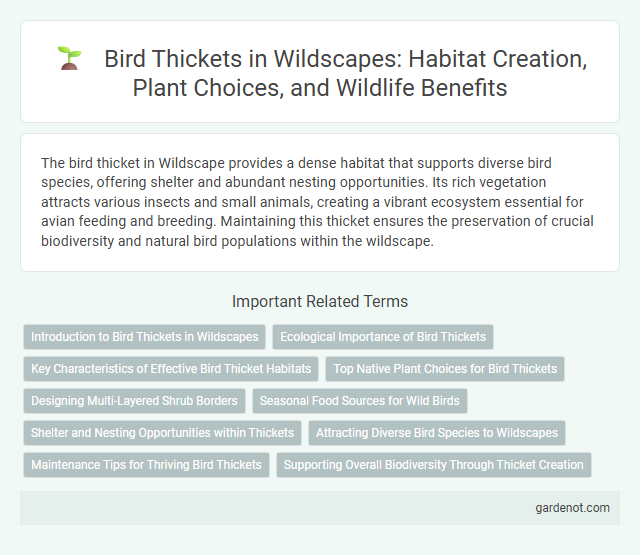The bird thicket in Wildscape provides a dense habitat that supports diverse bird species, offering shelter and abundant nesting opportunities. Its rich vegetation attracts various insects and small animals, creating a vibrant ecosystem essential for avian feeding and breeding. Maintaining this thicket ensures the preservation of crucial biodiversity and natural bird populations within the wildscape.
Introduction to Bird Thickets in Wildscapes
Bird thickets in wildscapes serve as vital habitats, providing dense vegetation that offers shelter, nesting sites, and abundant food sources for diverse bird species. These thickets contribute to ecosystem stability by supporting avian biodiversity and aiding in pollination and seed dispersal. Their presence enhances natural landscapes, promoting ecological balance and bird conservation efforts.
Ecological Importance of Bird Thickets
Bird thickets provide vital ecological functions by offering essential nesting sites and protective cover for diverse avian species, which supports local biodiversity. These dense vegetation areas contribute to pest control by attracting insectivorous birds, reducing the need for chemical interventions in ecosystems. Furthermore, bird thickets enhance seed dispersal and pollination processes, promoting healthy plant regeneration and overall habitat stability.
Key Characteristics of Effective Bird Thicket Habitats
Effective bird thicket habitats are characterized by dense, multi-layered vegetation that provides ample cover and nesting opportunities for various bird species. These habitats offer a mixture of shrubs, small trees, and ground cover, supporting diverse foraging options and protection from predators. The presence of native plant species and structural complexity enhances biodiversity and supports seasonal bird population fluctuations.
Top Native Plant Choices for Bird Thickets
For creating bird thickets in a wildscape, top native plant choices include common elderberry (Sambucus canadensis), black chokeberry (Aronia melanocarpa), and serviceberry (Amelanchier spp.), each providing abundant berries and shelter for birds. Native dogwood species like red osier dogwood (Cornus sericea) offer dense branches and nutrient-rich fruits that attract diverse bird populations. Including these plants supports local ecosystems by providing essential food sources and nesting sites for native avian species.
Designing Multi-Layered Shrub Borders
Designing multi-layered shrub borders in a bird thicket enhances habitat complexity and provides essential shelter, nesting sites, and food sources for various bird species. Incorporating diverse native shrubs of varying heights and densities creates vertical structure that attracts songbirds, fostering biodiversity within wildscape environments. Strategic planting of berry-producing and flowering shrubs supports seasonal foraging needs and promotes ecological balance.
Seasonal Food Sources for Wild Birds
Bird thickets provide essential seasonal food sources for wild birds by offering a variety of berries, seeds, and insects that change with the seasons. In spring and summer, insects and fresh foliage supply high-protein nourishment, while autumn brings an abundance of ripe berries such as elderberries and chokecherries critical for energy reserves before migration. Winter food availability relies heavily on persistent seed heads from native grasses and shrubs within the thicket, supporting bird survival during harsh conditions.
Shelter and Nesting Opportunities within Thickets
Wildscape bird thickets provide essential shelter and nesting opportunities by offering dense vegetation that protects birds from predators and harsh weather. The intricate layering of shrubs and small trees creates ideal microhabitats for ground and tree-nesting species to establish secure nests. These thickets enhance biodiversity by supporting a variety of bird species throughout breeding and migration seasons.
Attracting Diverse Bird Species to Wildscapes
Creating a dense bird thicket in wildscapes involves planting a variety of native shrubs and small trees that offer shelter, nesting sites, and a rich supply of berries and seeds. Species such as dogwood, elderberry, and serviceberry attract insects and provide vital food resources, supporting a diverse range of bird species including warblers, thrushes, and sparrows. Incorporating layered vegetation mimics natural habitats, enhancing biodiversity and encouraging the presence of both migratory and resident birds.
Maintenance Tips for Thriving Bird Thickets
Regular pruning of dense branches in bird thickets promotes healthy growth and prevents overcrowding, enhancing habitat quality for nesting birds. Incorporating native plant species supports local bird populations by providing natural food sources and shelter. Consistent removal of invasive plants and debris maintains optimal conditions for birds and encourages biodiversity within the wildscape.
Supporting Overall Biodiversity Through Thicket Creation
Bird thickets serve as critical habitats that support overall biodiversity by providing dense cover and nesting sites for various bird species. These thickets contribute to ecosystem health by fostering insect populations, which in turn sustain diverse avian communities. Establishing bird thickets enhances habitat complexity, promoting species richness and ecological balance within Wildscape environments.
Bird thicket Infographic

 gardenot.com
gardenot.com